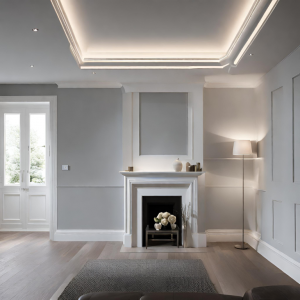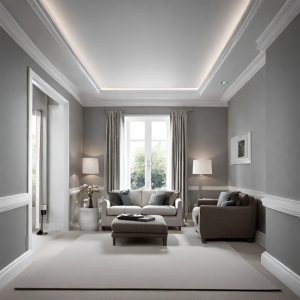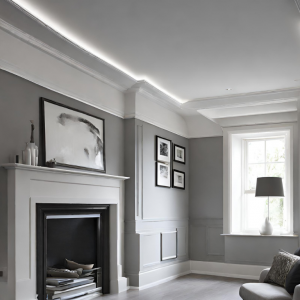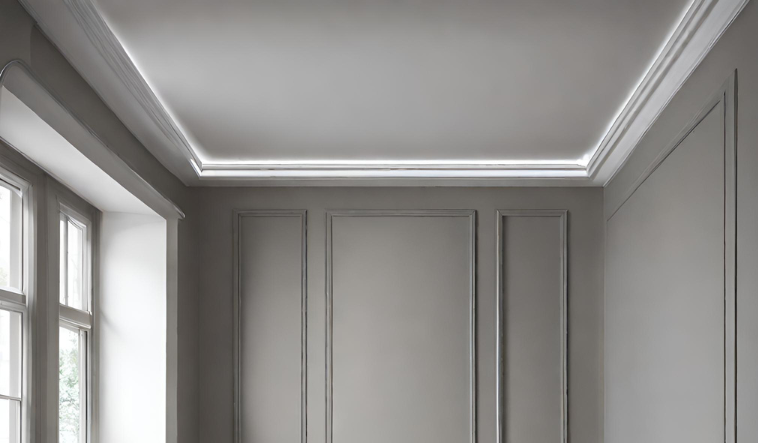How do you make coving look modern?

To achieve a modern aesthetic with coving, it’s essential to align your choice of coving style with your existing interior decor. For instance, if you reside in a period property characterized by intricate detailing, high ceilings, and spacious rooms, opting for a traditional coving style can provide the ideal finishing touch.
Decorating the intersection between a vertical wall and a horizontal ceiling may seem straightforward, but achieving a seamless transition between these fundamental structural elements can be a meticulous task.
When dealing with this junction, precise execution is crucial. To ensure a flawless connection, wallpaper must be cut precisely at a 90-degree angle to create a seamless join at the top.
Similarly, when dealing with painted walls, skillful cutting is required to achieve clean lines. Overcoming challenges can be more complex if your ceiling doesn’t consistently meet the wall at a perfect right angle.

One effective solution is to visually break up this junction by introducing a new element, which is where coving comes into play.
Incorporating coving into your ceiling design can achieve this classic look. First, paint or wallpaper your walls and then add white coving to match the colour of your ceiling.
However, it’s worth noting that coving doesn’t have to be exclusively white. For a fresh take on the classic look, consider using coving and painting both the ceiling and coving sections in the same colour.
Beneath the coved area, apply a treatment that complements this chosen tone. Adding a high picture rail can enhance the impact of this seamless design.

Coving serves a dual purpose. While it conceals the junction between the wall and ceiling, effectively camouflaging imperfections that may have developed over time due to the building settling, it can also become a prominent feature within a room.
In traditionally styled bedrooms with high ceilings, ornate coving can impart character and definition to the room’s decor, harmonizing with other design elements like drapes.
If your room already features fitted furniture, consider integrating coving into the overall look. As mentioned earlier, coving establishes a new connection between the wall and ceiling.
It can also be employed to link high storage units, such as bookcases, fitted wardrobes, and window pelmets, to the ceiling. This integration can provide a cohesive appearance that complements the room’s furnishings.

Although not mandatory for coved ceilings, picture rails contribute significantly to the overall effect. They delineate the boundary between the coved ceiling and the wall, adding definition.
Furthermore, picture rails, despite their original purpose, serve as an excellent means of hanging artwork in a room, particularly if you frequently rearrange your collection.
If your room already boasts a dominant colour scheme, coving offers an opportunity to introduce a distinct accent. For example, in spaces with coordinating tones on both walls and ceilings, utilizing coving allows you to create a contrasting accent.
For instance, green walls and ceiling can be beautifully complemented by white or brown coving, adding depth and visual interest to the room.
Do modern houses have coving?

Indeed, coving has found its place in modern residences as well. While traditional decor often leans towards elaborate designs and rich colours, contemporary interiors have warmly embraced coving too.
Modern coving tends to favor simplicity in its design, featuring clean and understated lines that still manage to make a noteworthy statement.

Its role in contemporary spaces is to soften the sharp edges and corners, fostering a more inviting ambiance within the home.
With its timeless charm and adaptability, coving offers the means to craft a distinct and welcoming interior, regardless of your chosen design style.
What can I put up instead of coving?

Mouldings serve as captivating decorative accents that enhance a room’s architectural character.
Typically crafted from materials like plaster, wood, or foam, these ornamental elements can be strategically placed throughout your home to elevate its aesthetic appeal.
While wood remains the most prevalent material for mouldings, other alternatives, including plastic, have emerged. Nonetheless, natural wood remains the favored choice.
In instances where budget constraints prohibit the use of natural wood, painting the mouldings to harmonize with your room’s style is a wise approach.

Polyurethane represents another alternative to coving. This durable and lightweight material boasts easy installation and resists warping, cracking, and peeling. While not as robust as natural wood, it serves as a commendable substitute.
Architectural cornices, often adorned with intricate patterns and available in various sizes, provide an exceptional means of enhancing a room’s visual appeal.
Picture frame moulding, exuding sophistication, can impart exquisite detail to a space and is commonly employed on door frames and window trim.
Crown mouldings, traditionally crafted from plaster, have diversified in material options, including foam, medium-density fiberboard, and plastics.

Dado rail and wainscoting represent other forms of decorative moulding.
Originally designed for wall protection, wainscoting, typically three to four feet in length, graces the lower portion of walls, particularly in older homes characterized by higher ceilings.
The Georgian Cornice presents an alluring alternative to coving, available in various materials, such as plastics and reformed wood, with gypsum plaster being the traditional choice.
Beyond their decorative function, mouldings serve practical purposes, aiding in weather-sealing natural joints and ensuring architectural functionality.

Certain alternatives to coving also serve as wall plinths for displaying small sculptures.
Delicate mouldings can be applied to feature walls to imbue a more formal ambiance.
When selecting a moulding design, keep in mind that different shapes cast varying shadows.
Lighter areas enhance the definition of decorative elements, while darker areas create striking contrasts, allowing for versatile design possibilities.
Is coving fashionable now?

While some argue that coving can overwhelm a room with excessive detail and ornamentation, promoting a cluttered and busy appearance, it’s important to note that this perception hasn’t diminished its popularity.
Many homeowners, interior designers, and builders still view it as a stylish and timeless feature capable of imparting character and elegance to a space.
One approach to keep coving fashionable in modern design is to embrace streamlined and simplistic designs.
Instead of opting for the intricate and ornate styles of the past, contemporary coving can feature clean lines, straightforward shapes, and neutral colour palettes that seamlessly integrate into the overall design scheme.

This approach fosters a sense of harmony and balance within the room.
In conclusion, coving shouldn’t be dismissed as old-fashioned. It remains a versatile decorative element capable of complementing a variety of design styles.
Whether you lean towards contemporary or traditional aesthetics, there exists a coving style to suit your preferences.
With a touch of creativity and imagination, coving can serve as a stunning addition to any home, demonstrating its enduring appeal in today’s interior design landscape.
Do rooms look better with or without coving?

Coving and cornice serve as ideal enhancements for accentuating the upper edges of walls, bestowing a tasteful and refined final flourish to elevate the overall appearance of a room.
They play a pivotal role in preventing the decor from appearing incomplete, filling in any gaps in the room’s detailing.
The question of whether rooms appear more appealing with or without coving largely hinges on personal preference and the desired aesthetic.

For those seeking a polished and sophisticated look, coving can significantly enhance the visual appeal of a room, adding a touch of elegance and completeness to the decor.
Conversely, those favoring a minimalist and unadorned design may opt to forgo coving for a simpler and more streamlined appearance.
Ultimately, the choice between coving or no coving depends on the individual’s stylistic vision and the ambiance they wish to create within the room.







